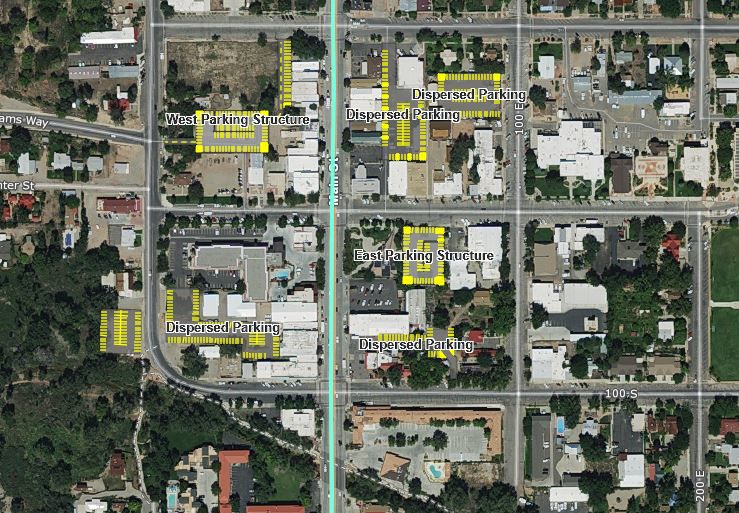Some information may be outdated.
Moab City and Grand County’s plan proposing new downtown parking was approved for funding on May 11 by the Utah Transportation Commission.
The Utah Transportation Commission approved $10 million in “Recreational Hot Spot” funding for the Arches National Park–Moab area. The funds are part of a total allocation of $100 million set aside by the Utah Legislature in 2017 for four prioritized areas in the state.
Plans for the Moab area are preliminary, and were submitted to the Utah Department of Transportation (UDOT) for consideration as a necessary measure to secure the funding.
Ideas in the plan include parking structures on 100 West and Center Street, and dispersed off-street parking lots within walking distance to Main Street.
Kevin Kitchen, communications manager for UDOT in region four, said those ideas for downtown parking are not finalized.
“The project scope is purely conceptual right now,” Kitchen said on May 14.
The project design is likely to change depending upon local input from the city’s development and community-identified needs. Kitchen said UDOT used software to help analyze criteria in the Moab area and that the recommendations for the parking plan came from the local level.
Officials with the City of Moab said that Grand County Council member Curtis Wells discovered the funding opportunity and alerted other city and county officials.
Wells said he raised the idea in a joint city-county meeting and formed a committee, which invited UDOT to the discussions around transportation, infrastructure and funding in the area. The committee meetings helped UDOT understand Moab and Grand County’s involvement in the special funding process, Wells said.
The county and city then worked together with UDOT to meet with other community stakeholders to identify criteria, and develop the preliminary details of the plan.
“It’s not every day that we have an opportunity to secure funding like this, and I’m proud of our county and city for working so effectively with UDOT’s team to develop a successful proposal,” Wells said. “The (Utah) Legislature recognized that tourism-based communities have unique challenges, and our community will benefit directly from UDOT’s allocation of Hot Spot funds.”
Wells added that sometimes in remote Southeastern Utah, it can “feel like we’re out of the loop, off the radar” when it comes to securing funds for transportation and infrastructure.
Moving forward, UDOT will oversee and manage the project, but will continue to work closely with the city, and potentially the county, on developing the downtown parking plans.
Moab City Manager David Everitt said that creating solutions for parking is an important part of the city’s overall downtown planning process. The city’s goal is to help mitigate traffic congestion, and create safe parking spaces for people working and visiting in the area.
“We’re very excited because UDOT got this $10 million,” Everitt said.
Everitt said the Utah Legislature, through Senate Bill 277, developed broad parameters for how the funds may be spent in the Moab area.
Both Everitt and Kitchen said the lack of specificity in how the funds may be spent allows for the project to continue to be developed based on the specific needs of the community.
“I think it reflects that they want to make the community input a part of the project,” Everitt said.
“It’s an example of the good things that can happen if we take the initiative and get involved at the state level,” Wells said.
The Moab Transit Authority Study Committee met on Tuesday, May 15, to discuss transportation, infrastructure and transit solutions in the Arches National Park–Moab area.
Grand County Community and Economic Development Director Zacharia Levine said the $10-million allocation shows how county and city efforts to become involved in transportation planning at the state level are beneficial for the community.
“That, I think, is the beginning of a much larger transportation planning program,” Levine said.
Other “Recreational Hot Spot” funding areas initially selected for study included Little Cottonwood Canyon in Salt Lake County, Bear Lake, and the Zion National Park–St. George area.
The UDOT projects will now be placed on the five-year Statewide Transportation Improvement Plan (STIP) to begin design and subsequent construction.
Kitchen said UDOT’s project manager will begin shaping the design process for the downtown parking plan. Funding will be available in July at the start of the new fiscal year.
Everitt said a lot of preliminary ideas have been presented to the city to mitigate traffic congestion and parking issues. Among those preliminary ideas are the removal of parallel parking along the downtown central stretch of Main Street, and the creation of a traffic tunnel underneath the street for freight trucks.
A separate UDOT project to widen U.S. Hwy. 191 north of Moab starting at 400 North and extending to the Colorado River bridge will remove some of the parallel parking spaces on Main Street.
Kitchen said other Main Street parking spaces in the central downtown area are not planned for removal by any of UDOT’s current plans.
More than 17,000 vehicles travel on Main Street through downtown Moab each day, according to UDOT.
County councilmember Wells alerted city to $10 million in state funds for Arches, Moab congestion
“It’s not every day that we have an opportunity to secure funding like this, and I’m proud of our county and city for working so effectively with UDOT’s team to develop a successful proposal.”
– Curtis Wells
Appreciate the coverage? Help keep local news alive.
Chip in to support the Moab Sun News.





